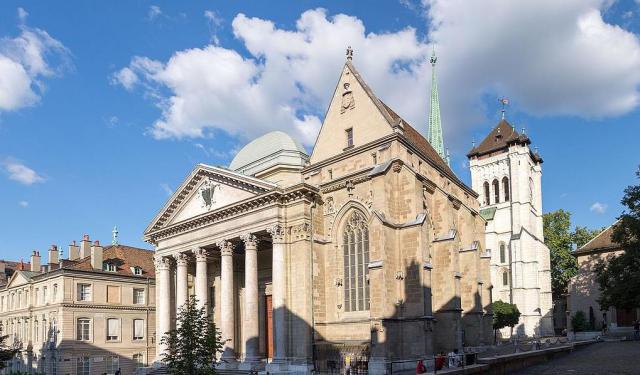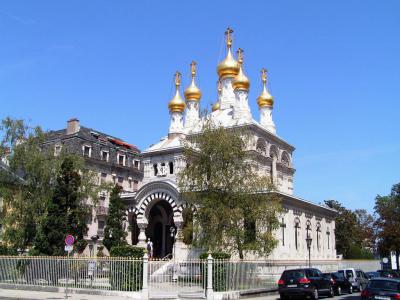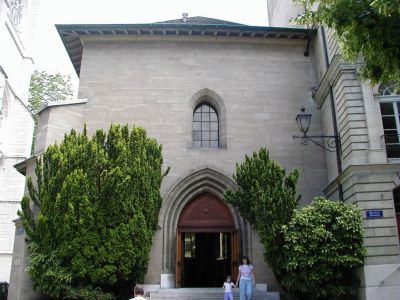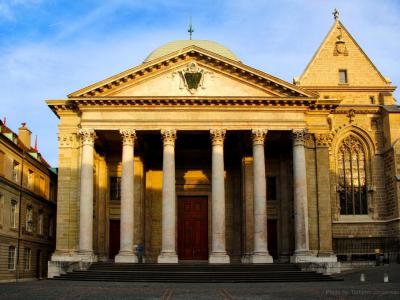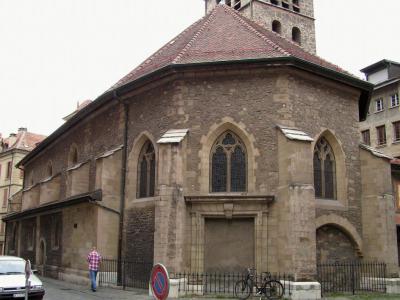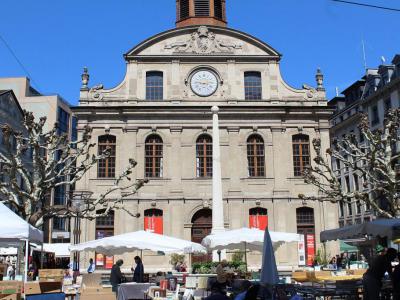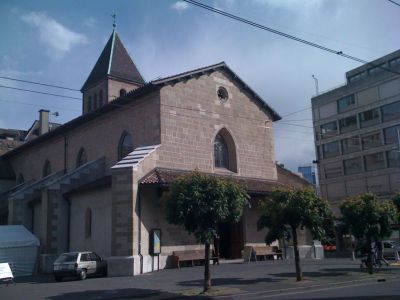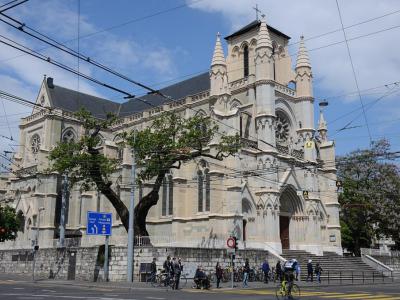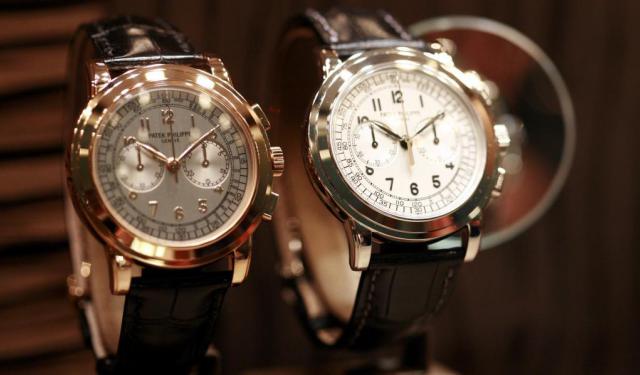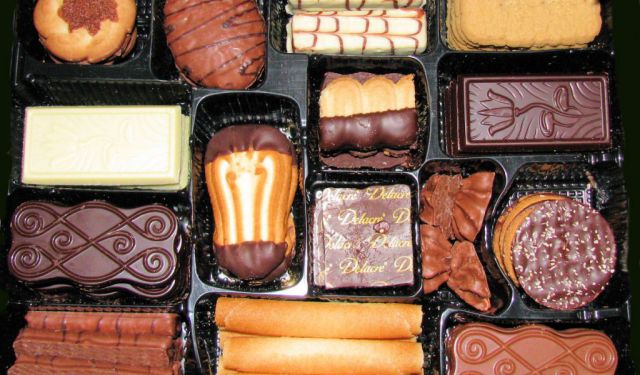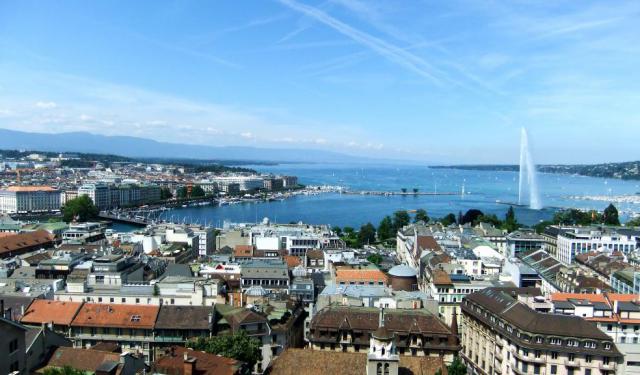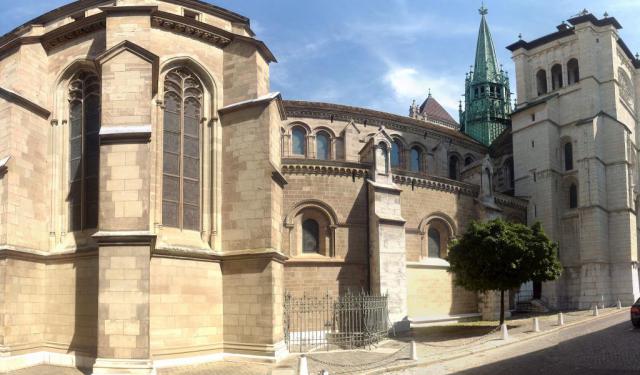Historical Churches (Self Guided), Geneva
As the cradle of the Reformist movement in Europe led by theologian Jean Calvin, the city of Geneva has no shortage of religious sites representing a great deal of historical and cultural value. A dedicated Christian, a keen churchgoer, or simply one who is interested in objects of spirituality will find here quite a few temples worthy of attention.
Whether you're drawn to the austere beauty of the Auditoire de Calvin, the Gothic grandeur of Saint Peter's Cathedral (Cathédrale de Saint Pierre), or the cultural diversity represented by the Russian Church (Eglise Russe) and Basilique Notre-Dame, these churches invite you to explore Geneva's past and present.
The Saint-Germain Church (Eglise Saint-Germain) is a charming example of medieval masonry. Its history dates back to the 9th century, and it features a blend of Romanesque and Gothic elements.
The Temple de la Fusterie is a Protestant church known for its elegant Baroque design. Built in the 18th century, it reflects the city's commitment to religious tolerance and diversity. The graceful facade and serene interior make it a welcoming place for reflection.
The Temple Saint-Gervais, with its Romanesque style, also adds to Geneva's architectural diversity. The first church on the site was built as far back as the 4th century.
If you find yourself in Geneva, take the time to explore these magnificent churches and experience the deep historical and spiritual significance they hold. It's a journey worth taking that will not only enrich your understanding of the city but also provide a sense of connection to its remarkable past.
Whether you're drawn to the austere beauty of the Auditoire de Calvin, the Gothic grandeur of Saint Peter's Cathedral (Cathédrale de Saint Pierre), or the cultural diversity represented by the Russian Church (Eglise Russe) and Basilique Notre-Dame, these churches invite you to explore Geneva's past and present.
The Saint-Germain Church (Eglise Saint-Germain) is a charming example of medieval masonry. Its history dates back to the 9th century, and it features a blend of Romanesque and Gothic elements.
The Temple de la Fusterie is a Protestant church known for its elegant Baroque design. Built in the 18th century, it reflects the city's commitment to religious tolerance and diversity. The graceful facade and serene interior make it a welcoming place for reflection.
The Temple Saint-Gervais, with its Romanesque style, also adds to Geneva's architectural diversity. The first church on the site was built as far back as the 4th century.
If you find yourself in Geneva, take the time to explore these magnificent churches and experience the deep historical and spiritual significance they hold. It's a journey worth taking that will not only enrich your understanding of the city but also provide a sense of connection to its remarkable past.
How it works: Download the app "GPSmyCity: Walks in 1K+ Cities" from Apple App Store or Google Play Store to your mobile phone or tablet. The app turns your mobile device into a personal tour guide and its built-in GPS navigation functions guide you from one tour stop to next. The app works offline, so no data plan is needed when traveling abroad.
Historical Churches Map
Guide Name: Historical Churches
Guide Location: Switzerland » Geneva (See other walking tours in Geneva)
Guide Type: Self-guided Walking Tour (Sightseeing)
# of Attractions: 7
Tour Duration: 1 Hour(s)
Travel Distance: 2.2 Km or 1.4 Miles
Author: john
Sight(s) Featured in This Guide:
Guide Location: Switzerland » Geneva (See other walking tours in Geneva)
Guide Type: Self-guided Walking Tour (Sightseeing)
# of Attractions: 7
Tour Duration: 1 Hour(s)
Travel Distance: 2.2 Km or 1.4 Miles
Author: john
Sight(s) Featured in This Guide:
- Eglise Russe (Russian Church)
- Auditoire de Calvin (Calvin Auditorium)
- Cathédrale de St. Pierre (Saint Peter Cathedral)
- Eglise Saint-Germain
- Temple de la Fusterie
- Temple Saint-Gervais
- Basilique Notre-Dame
1) Eglise Russe (Russian Church)
The Russian Church (Eglise Russe), otherwise known as the Cathedral of the Exaltation of the Holy Cross, is a historic Russian Orthodox temple in Geneva attached to a parish established on the orders of Emperor Alexander I in 1817. The temple was built in 1866, funded with generous donations by the Russian Grand Duchess Anna Fyodorovna, who lived in Switzerland at that time after separating from her husband, Grand Duke Constantine, as well as other members of the Imperial family of Alexander II (Michael, Olga, Constantine, Helena, Mary and Nicholas of Leuchtenberg), plus the Metropolitan of Kiev, Arsenius Moskvin.
The emergence of this church became possible after the revolution of 1846, following which the Geneva Constitution of 1847 guaranteed freedom of worship to various religious communities within the city. Among them was a small Russian diaspora comprising diplomats, military officers, aristocrats, engineers, civil servants, tourists, students and even left-wing activists. The building features Byzantine design, topped with nine bright golden onion domes and striped arches: five above the nave (symbolizing Jesus Christ and the four Evangelists), three on the apses, and one on the bell tower. Their total number represents the hierarchy of angels, composed of nine choirs.
The construction was carried out by Geneva-based architect, Jean-Pierre Guillebaud, to the design made by professor of architecture at the Imperial Academy of Fine Arts in Saint Petersburg, David Grimm. The foundation stone was laid on September 26, 1863 in the presence of Princes Serge and Georges de Leuchtenberg, the Russian Ambassador to Switzerland, as well as the State Councilor, Moïse Vautier. After three years of work, the church was completed on September 14, 1866 and was consecrated on September 26 of the same year by the Archpriests Joseph Vasiliev of Paris, Vassili Polejaiev of Nice, and Athanase Pétroff.
The Russian Church remains in active use to date, with the services held in Russian, Bulgarian, Serbian, and other languages.
The emergence of this church became possible after the revolution of 1846, following which the Geneva Constitution of 1847 guaranteed freedom of worship to various religious communities within the city. Among them was a small Russian diaspora comprising diplomats, military officers, aristocrats, engineers, civil servants, tourists, students and even left-wing activists. The building features Byzantine design, topped with nine bright golden onion domes and striped arches: five above the nave (symbolizing Jesus Christ and the four Evangelists), three on the apses, and one on the bell tower. Their total number represents the hierarchy of angels, composed of nine choirs.
The construction was carried out by Geneva-based architect, Jean-Pierre Guillebaud, to the design made by professor of architecture at the Imperial Academy of Fine Arts in Saint Petersburg, David Grimm. The foundation stone was laid on September 26, 1863 in the presence of Princes Serge and Georges de Leuchtenberg, the Russian Ambassador to Switzerland, as well as the State Councilor, Moïse Vautier. After three years of work, the church was completed on September 14, 1866 and was consecrated on September 26 of the same year by the Archpriests Joseph Vasiliev of Paris, Vassili Polejaiev of Nice, and Athanase Pétroff.
The Russian Church remains in active use to date, with the services held in Russian, Bulgarian, Serbian, and other languages.
2) Auditoire de Calvin (Calvin Auditorium)
The Calvin Auditorium, originally named Notre-Dame-la-Neuve Chapel and known in French as Auditoire de Calvin, is a chapel with a pivotal role in the Protestant Reformation. It's notably linked with figures like Jean Calvin, Theodore Beza, and John Knox.
Located next to Saint Pierre Cathedral at Place de la Taconnerie, this simple Gothic structure was built in the 15th century, replacing a 5th-century temple, and was first dedicated to Notre Dame la Neuve.
Starting in 1536, during Geneva's Reformation, it became a lecture hall where Jean Calvin taught his reformation ideas. Bible studies were held here at 7 AM daily. In 1559, it was the first location for the University of Geneva. After Geneva embraced the Reformation, it turned into a sanctuary for Protestant refugees from Europe, who were allowed to worship here in their languages.
The church was also a refuge for the Scottish reformer John Knox in the 1550s. During his exile in Geneva, he led an English-speaking congregation and developed key ideas for the Scottish Reformation. It later became a meeting place for various Protestant refugee groups, including Italian Waldensians, Dutch Reformed, and Scottish Presbyterians. Consequently, it's regarded by many Reformed churches globally as a foundation of their faith.
Today, in line with Calvin's traditions, this Protestant chapel continues to hold services in multiple languages including French, English, Dutch, German, Italian, and Latin. It serves as the primary place of worship for the Italian Reformed Church and the Church of Scotland every Sunday.
Located next to Saint Pierre Cathedral at Place de la Taconnerie, this simple Gothic structure was built in the 15th century, replacing a 5th-century temple, and was first dedicated to Notre Dame la Neuve.
Starting in 1536, during Geneva's Reformation, it became a lecture hall where Jean Calvin taught his reformation ideas. Bible studies were held here at 7 AM daily. In 1559, it was the first location for the University of Geneva. After Geneva embraced the Reformation, it turned into a sanctuary for Protestant refugees from Europe, who were allowed to worship here in their languages.
The church was also a refuge for the Scottish reformer John Knox in the 1550s. During his exile in Geneva, he led an English-speaking congregation and developed key ideas for the Scottish Reformation. It later became a meeting place for various Protestant refugee groups, including Italian Waldensians, Dutch Reformed, and Scottish Presbyterians. Consequently, it's regarded by many Reformed churches globally as a foundation of their faith.
Today, in line with Calvin's traditions, this Protestant chapel continues to hold services in multiple languages including French, English, Dutch, German, Italian, and Latin. It serves as the primary place of worship for the Italian Reformed Church and the Church of Scotland every Sunday.
3) Cathédrale de St. Pierre (Saint Peter Cathedral) (must see)
The locale of the Cathedral of Saint Peter in Geneva has been the site of a cathedral and the seat of a bishop since the 4th century. The present cathedral was the work of the Prince-Bishop of the diocese, Arducius de Faucigny, in 1160. It was begun in the Gothic style, and there have been some changes since then.
The Cathedral of Saint Peter combines styles with a Neo-Classical Roman temple portico adjoined to a high-steepled Gothic edifice with a tall mullioned window. In 1535 French theologian John Calvin and the Reformation arrived in Geneva. Calvin adopted the cathedral as his home church, ushering in an age of architectural iconoclasm.
The cathedral was mostly stripped. The altars, all of the statues, and most paintings were destroyed or removed. The pulpit and some paintings were spared. The interior is spacious and plain, illuminated by hanging chandeliers. There are rows of benches and a few chapels. The aisles hold tombstones of 15th and 16th-century church dignitaries.
At the highest point of the Old Town, there is a stunning panorama for visitors hardy enough to brave the 157 steps of the north tower. The cathedral is often a venue for concerts. There is an archeological site in the crypt with artifacts of a 4th-century basilica. The 14th-century Chapel of the Maccabees should not be missed.
An enormous pipe organ is situated above the main entrance. It has the appearance of a red and gold crown. Loudspeakers are installed to magnify the already sonorous sound. If that is not enough, another, smaller organ is in the front on the left side. John Calvin's triangular stool is still next to the pulpit.
On the north side of the cathedral is the International Museum of the Reformation. The museum is open from Tuesday to Sunday from 10 am to 5 pm. A five-minute walk away is the Museum of Art and History. It has historical artifacts from the cathedral and the Saint Peter altarpiece painted by German artist Konrad Witz.
The Tower clock strikes every hour, followed by a tune on the glockenspiel, sometimes it's the Swiss National Anthem.
The Cathedral of Saint Peter combines styles with a Neo-Classical Roman temple portico adjoined to a high-steepled Gothic edifice with a tall mullioned window. In 1535 French theologian John Calvin and the Reformation arrived in Geneva. Calvin adopted the cathedral as his home church, ushering in an age of architectural iconoclasm.
The cathedral was mostly stripped. The altars, all of the statues, and most paintings were destroyed or removed. The pulpit and some paintings were spared. The interior is spacious and plain, illuminated by hanging chandeliers. There are rows of benches and a few chapels. The aisles hold tombstones of 15th and 16th-century church dignitaries.
At the highest point of the Old Town, there is a stunning panorama for visitors hardy enough to brave the 157 steps of the north tower. The cathedral is often a venue for concerts. There is an archeological site in the crypt with artifacts of a 4th-century basilica. The 14th-century Chapel of the Maccabees should not be missed.
An enormous pipe organ is situated above the main entrance. It has the appearance of a red and gold crown. Loudspeakers are installed to magnify the already sonorous sound. If that is not enough, another, smaller organ is in the front on the left side. John Calvin's triangular stool is still next to the pulpit.
On the north side of the cathedral is the International Museum of the Reformation. The museum is open from Tuesday to Sunday from 10 am to 5 pm. A five-minute walk away is the Museum of Art and History. It has historical artifacts from the cathedral and the Saint Peter altarpiece painted by German artist Konrad Witz.
The Tower clock strikes every hour, followed by a tune on the glockenspiel, sometimes it's the Swiss National Anthem.
4) Eglise Saint-Germain
The Saint-Germain Church in Geneva is a historically significant Catholic church, originally one of the city's seven main parishes. Constructed in the Gothic style during the 15th century, it initially served as a Protestant church. This structure replaced earlier versions: a 9th-century early Christian basilica and a 12th-century Romanesque church, which underwent reconstruction in 1334 after a fire.
In 1535, the church was the site of Geneva's first Reformation sermon. Later, from 1537 to 1554, it was repurposed as a butcher's shop. It returned to its religious roots in the 18th century, temporarily taking over the role of the Saint-Pierre cathedral as a Protestant place of worship.
Following the French invasion in the 19th century and the 1801 concordat between Pope Pius VII and Napoleon Bonaparte, which required local acceptance of a Roman Catholic church, Saint-Germain was chosen for conversion in 1803. In 1873, it was handed over to the Christian Catholic Church and, after the 1907 Church-State separation, became the property of Geneva's Christian Catholic Church.
An early 20th-century fire in the bell tower led to the loss of the original bells. A replacement bell, weighing 120 kilos and crafted in 1764 by Jean-Louis Revillard, was sourced from the city's clock tower. The restoration, including this change, lasted from 1906 to 1908. In 1908, a morning-hour-specific sundial, designed by Albert Schmidt, was placed outside the sacristy wall above a fountain. It features a depiction of death on a donkey under the sun, symbolizing life's transience.
Designated as a historic monument and a national cultural asset in 1921, the church has been hosting outdoor classical music concerts each summer since 1973. In 2008, commemorating 100 years since the 1908 refurbishment of the bell tower, two new bells were installed. These bells, with weights of 260 kilograms and 70 kilograms, were made by Paccard Foundry in Annecy.
In 1535, the church was the site of Geneva's first Reformation sermon. Later, from 1537 to 1554, it was repurposed as a butcher's shop. It returned to its religious roots in the 18th century, temporarily taking over the role of the Saint-Pierre cathedral as a Protestant place of worship.
Following the French invasion in the 19th century and the 1801 concordat between Pope Pius VII and Napoleon Bonaparte, which required local acceptance of a Roman Catholic church, Saint-Germain was chosen for conversion in 1803. In 1873, it was handed over to the Christian Catholic Church and, after the 1907 Church-State separation, became the property of Geneva's Christian Catholic Church.
An early 20th-century fire in the bell tower led to the loss of the original bells. A replacement bell, weighing 120 kilos and crafted in 1764 by Jean-Louis Revillard, was sourced from the city's clock tower. The restoration, including this change, lasted from 1906 to 1908. In 1908, a morning-hour-specific sundial, designed by Albert Schmidt, was placed outside the sacristy wall above a fountain. It features a depiction of death on a donkey under the sun, symbolizing life's transience.
Designated as a historic monument and a national cultural asset in 1921, the church has been hosting outdoor classical music concerts each summer since 1973. In 2008, commemorating 100 years since the 1908 refurbishment of the bell tower, two new bells were installed. These bells, with weights of 260 kilograms and 70 kilograms, were made by Paccard Foundry in Annecy.
5) Temple de la Fusterie
Located in the eponymous square at the heart of the Old Town of Geneva, the Temple de la Fusterie is a Reformed church that is distinguished from other local churches as the first religious site in the city specifically built for Calvinist worship. It was designed by architect Jean Vennes, taking two years to build – from 1713, and was consecrated on December 15, 1715.
Amid the inflow of oppressed Huguenot refugees from France to Geneva, the church imitated – in terms of both, architectural style and spatial planning – the Huguenot temple in the Paris suburb of Charenton-le-Pont that was designed by influential French architect Salomon de Bross in 1623 and destroyed in 1686.
The temple boasts late Baroque style, with a big clock at the top of the main façade. Contrary to the latter, the interior is rather modest, with a dormant and encircling gallery of Tuscan order colonnades and another colonnade set above the gallery, supporting the ceiling, which is flat, thus creating a basket arch vault above the main room of the nave.
Initially, the temple did not have an organ, which appeared only in the middle of the 18th century. The visual centerpiece of the church is the organ loft of the detached pulpit. Known for its excellent acoustics, the church serves as a concert hall these days. The musical performances last about 15 minutes.
Amid the inflow of oppressed Huguenot refugees from France to Geneva, the church imitated – in terms of both, architectural style and spatial planning – the Huguenot temple in the Paris suburb of Charenton-le-Pont that was designed by influential French architect Salomon de Bross in 1623 and destroyed in 1686.
The temple boasts late Baroque style, with a big clock at the top of the main façade. Contrary to the latter, the interior is rather modest, with a dormant and encircling gallery of Tuscan order colonnades and another colonnade set above the gallery, supporting the ceiling, which is flat, thus creating a basket arch vault above the main room of the nave.
Initially, the temple did not have an organ, which appeared only in the middle of the 18th century. The visual centerpiece of the church is the organ loft of the detached pulpit. Known for its excellent acoustics, the church serves as a concert hall these days. The musical performances last about 15 minutes.
6) Temple Saint-Gervais
The Saint-Gervais Temple is a Protestant church located in the neighborhood of Geneva that shares its name. Its history dates back to the 4th century when the first temple was constructed on this site. In the 10th century, a Romanesque church replaced the original one. Over the years, this church underwent significant changes, especially after a fire in 1345. A complete reconstruction took place in 1436, and it was dedicated to Saint Gervais, which led to the naming of the surrounding district.
In the 17th century, the church underwent further substantial renovations, adopting a Gothic style. The funding for these renovations came from donations from local watchmakers, jewelers, and goldsmiths who lived in the area.
With the advent of the Protestant Reformation, the church was repurposed for Protestant worship. During this transformation, a pulpit was installed in the nave, and galleries were added along the north side, although most of them were later removed in 1903, with one being transformed into a sacristy. In 1901, a significant restoration project took place, including the addition of several stained glass windows, including one by Henri Demole depicting the theme of Escalade on the eastern side.
Beneath the temple, there is an archaeological site, which is also protected and includes the remains of a Gallo-Roman building and an early Christian church. Excavations were conducted in two phases, from 1987 to 1994, and then from 2000 to 2005, covering an area of nearly 2,000 square meters. This archaeological site is open to the public and can be explored as part of an archaeological tour.
The Saint-Gervais Temple is currently designated as a Swiss cultural heritage site of national significance and is frequently utilized as a venue for concerts.
In the 17th century, the church underwent further substantial renovations, adopting a Gothic style. The funding for these renovations came from donations from local watchmakers, jewelers, and goldsmiths who lived in the area.
With the advent of the Protestant Reformation, the church was repurposed for Protestant worship. During this transformation, a pulpit was installed in the nave, and galleries were added along the north side, although most of them were later removed in 1903, with one being transformed into a sacristy. In 1901, a significant restoration project took place, including the addition of several stained glass windows, including one by Henri Demole depicting the theme of Escalade on the eastern side.
Beneath the temple, there is an archaeological site, which is also protected and includes the remains of a Gallo-Roman building and an early Christian church. Excavations were conducted in two phases, from 1987 to 1994, and then from 2000 to 2005, covering an area of nearly 2,000 square meters. This archaeological site is open to the public and can be explored as part of an archaeological tour.
The Saint-Gervais Temple is currently designated as a Swiss cultural heritage site of national significance and is frequently utilized as a venue for concerts.
7) Basilique Notre-Dame
The Basilique de Notre-Dame serves as the primary Catholic church in Geneva. It was constructed between 1852 and 1857 based on the architectural plans of Alexandre Grigny. The basilica stands on the former site of defensive fortifications. This Neo-Gothic structure draws some of its design inspiration from the Beauvais Cathedral. Its establishment was made possible through a combination of factors, including the city of Geneva granting land to religious communities for the construction of places of worship, along with donations and manual labor contributed by the Catholic community in Geneva.
Inside the basilica, there is a statue of Our Lady of Geneva, a gift from Pope Pius IX, which is highly revered. However, the basilica is particularly renowned for its stained glass windows. While some of these windows are produced in a semi-industrial Neo-Gothic style, most of them showcase the evolution of stained glass art during the 20th century. These windows come in various styles, following the era of Claudius Lavergne, who installed them between 1857 and 1875. Starting in 1912, several artists have contributed to the decoration of the basilica, including Charles Brunner, Alexandre Cingria, Maurice Denis, Gherri Moro, Paul Monnier, Jean-Claude Morend, and Théodore Strawinsky.
The basilica has been recognized as a culturally significant National Heritage Site.
Inside the basilica, there is a statue of Our Lady of Geneva, a gift from Pope Pius IX, which is highly revered. However, the basilica is particularly renowned for its stained glass windows. While some of these windows are produced in a semi-industrial Neo-Gothic style, most of them showcase the evolution of stained glass art during the 20th century. These windows come in various styles, following the era of Claudius Lavergne, who installed them between 1857 and 1875. Starting in 1912, several artists have contributed to the decoration of the basilica, including Charles Brunner, Alexandre Cingria, Maurice Denis, Gherri Moro, Paul Monnier, Jean-Claude Morend, and Théodore Strawinsky.
The basilica has been recognized as a culturally significant National Heritage Site.
Walking Tours in Geneva, Switzerland
Create Your Own Walk in Geneva
Creating your own self-guided walk in Geneva is easy and fun. Choose the city attractions that you want to see and a walk route map will be created just for you. You can even set your hotel as the start point of the walk.
Best Swiss Watch Shops Tour
When it comes to quality and precision, Swiss-made watches are known to be the best. Some of the world-renowned watch brands have been designed and masterminded in Geneva. The city's watch industry dates back to the 16th century, and since then has constantly developed to produce the most desired timepieces.
Geneva hosts a cluster of specialized shops that cater to the refined tastes of... view more
Tour Duration: 1 Hour(s)
Travel Distance: 1.2 Km or 0.7 Miles
Geneva hosts a cluster of specialized shops that cater to the refined tastes of... view more
Tour Duration: 1 Hour(s)
Travel Distance: 1.2 Km or 0.7 Miles
Chocolate Tour
Chocolate started to gain popularity in Switzerland in the early 16th century and has since evolved to become a highly appreciated Swiss commodity throughout the world. Almost every city or town in the country has at least one chocolate shop, and Geneva is by far no exception.
The local chocolate scene is a true delight for any cocoa enthusiast. Here, you'll find a handful of iconic... view more
Tour Duration: 1 Hour(s)
Travel Distance: 1.5 Km or 0.9 Miles
The local chocolate scene is a true delight for any cocoa enthusiast. Here, you'll find a handful of iconic... view more
Tour Duration: 1 Hour(s)
Travel Distance: 1.5 Km or 0.9 Miles
Geneva Introduction Walking Tour
The city of Geneva enjoys picturesque location at the southern tip of the expansive Lac Léman (aka Lake Geneva), surrounded by the Alps and Jura mountains, including the dramatic Mont Blanc peak.
The city was mentioned for the first time in Latin texts, by Caesar, with the spelling Genava, derived probably from the Celtic genawa- or genu- ("bend, knee"), in the sense of a bending... view more
Tour Duration: 2 Hour(s)
Travel Distance: 2.6 Km or 1.6 Miles
The city was mentioned for the first time in Latin texts, by Caesar, with the spelling Genava, derived probably from the Celtic genawa- or genu- ("bend, knee"), in the sense of a bending... view more
Tour Duration: 2 Hour(s)
Travel Distance: 2.6 Km or 1.6 Miles
Architectural Jewels
Geneva, a city renowned for its diplomatic prowess and picturesque landscapes, boasts an array of architectural jewels. The remarkable medieval and more contemporary structures such as Geneva Town Hall (Hôtel de Ville), Saint Peter Cathedral (Cathedrale de Saint-Pierre), and Schtroumph Buildings, showing a mix of French and German influences, have captivated both locals and tourists for decades.
... view more
Tour Duration: 2 Hour(s)
Travel Distance: 2.6 Km or 1.6 Miles
... view more
Tour Duration: 2 Hour(s)
Travel Distance: 2.6 Km or 1.6 Miles
The Most Popular Cities
/ view all
